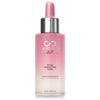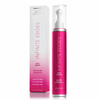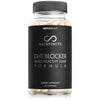
Hair Miniaturization: What it is and How to Stop it
The technical name for balding or hair shedding or hair loss is hair miniaturization.
This process is most typical in men, inhibiting the hair follicles and making it hard to grow healthy and strong hair.
Hair miniaturization is when hair strands become shorter, thinner, frazzled, and weaker with each subsequent progression through the cycle of hair growth. When left untreated, miniaturization leads to the appearance of lackluster, dry, and thin hair or may even stop the growth of hair completely.
Hair Miniaturization has many causes, and it's one of the leading causes of pattern baldness. However, the good news is this condition can be effectively treated, especially when caught early.
If you've been suffering from hair miniaturization and have been looking for the best solutions, then worry no more as you're in the right place. This article will discuss hair miniaturization, what causes it, and how to stop it - home remedies and clinical treatments. Grab a chilled juice as you go through this guide!
What is Hair Miniaturization?
Hair miniaturization is a condition that causes hair follicles to compress, thereby making the growth of new hair strands difficult.
This means that the once viable follicles producing robust and healthy hair will start producing thinner strands with a weak shaft that can fall out easily.
Hair strands are protein filaments that grow from follicles located in certain body parts. A healthy follicle promotes a healthy growth cycle: growth - change - and shedding. This is a continuous process throughout our life, enabling us to have complete hair with little or no hair loss.
Sadly, not every one of us is this lucky! A large percentage of humans around the globe experience some form of baldness in their lives, which is likely going to lead to hair miniaturization.
Hair miniaturization is more common among men, especially those with Androgenetic Alopecia (AGA), a form of pattern baldness.
What is the Role of Hair Miniaturization in Hair Loss
You might be wondering what linked hair miniaturization to hair loss. If you carefully look at the hair growth cycle, you'll understand.
All hair on the human body begins as Vellus hair and then graduates to terminal hair. This mostly happens during the embryo's development and as part of puberty.
Terminal hairs are more robust, healthier, and more prominent. They usually pass through stages which are:
Anagen Phase: This refers to the growth phase, it lasts for about five years and is the main stage of the hair growth cycle.
Catagen Phase: This is the transition phase and the shortest among the three. It lasts between one to two weeks, and it's the intervening stage between growth and rest.
Telogen Phase: The telogen phase refers to the resting stage, and it lasts for about four months. At this phase, the shedding of hair increases as old and fragile hair falls out, giving way to new and healthier hair growth. This takes us back to the Anagen phase, and the cycle continues throughout our lives.
However, in people experiencing hair miniaturization, the telogen and anagen phases are altered in these ways:
- The Anagen Phase is shortened, thereby reducing the number of hair shafts that will grow.
- The Telogen Phase is prolonged, during which there's no growth of new hair strands.
These changes lead to thinner and shorter hair growth and cause the hair follicles to shrink and disappear with time.
Causes of Hair Miniaturization
Many reasons cause miniaturization. Below are the five top causes of this condition:
-
Genetics
The leading cause of hair miniaturization is genetics. Studies have shown that the more your relatives are affected with male pattern baldness, the more likely you will develop it.
Androgenic Alopecia (male pattern baldness) is a common hair loss disorder inherited chiefly. Statistics by the NIH have shown that about 30 million men in America and millions of females are affected by the disease.
Male pattern baldness mostly starts with hair receding at the temporal sides of the head, creating an M shape on the head. If the condition worsens, miniaturization can also extend to the top of the head. As miniaturization makes hair thinner and more fragile, hair growth might cease in the area leading to complete baldness.
-
Telogen Effluvium
This is a condition in which the hair prematurely enters the hair cycle's telogen phase (resting phase). This will result in the affected area having sparse hair over time. When hair grows in the area, it's usually thinner and fragile, thus showing the signs of hair miniaturization.
A deficiency in specific nutrients, stress, physical trauma, or side effects of certain prescription medications mainly causes telogen Effluvium.
-
Dihydrotestosterone (DHT)
Another leading cause of hair miniaturization is DHT. This hormone is produced when the 5α-reductase enzyme synthesizes testosterone. Depending on the synthesis rate, the level of DHT varies from one individual to another.
Too much DHT in the scalp affects its health and functionality, leading to shrinkage and the disappearance of hair follicles.
This way, DHT causes hair miniaturization by shrinking the hair follicles and making them incapable of growing healthy and strong hair.
-
Aging
The most common cause of hair miniaturization is aging. There is so much scientific research that backs this up.
One evidence that aging causes hair miniaturization is the wear and tear theory, which highlights that our body cells have a maximum time when they can function normally. They begin to slow down due to natural wear and tear.
Another theory relating aging to hair miniaturization is the free radicals theory. According to the free radical theory, aging occurs due to the weakening of the body cells and tissues due to the accumulation of oxidative stress in the body caused by free radicals build-up and exposure to ultraviolet rays.
These reasons make hair follicles shrink over time, leading to the inability to produce healthy hair, which will cause miniaturization and thinning.
-
Deficiency in Nutrients
Our hair needs certain minerals and nutrients to grow like other body parts. Deficiency in nutrients like biotin, vitamin D, Omega-3-fatty-acids, and iron can lead to hair growth of fragile hair, indirectly leading to hair thinning and miniaturization.
It's essential to eat a nutritious and balanced diet containing zinc, magnesium, proteins, iron, and other healthy hair nutrients that promote the growth of healthy and glossy hair.
Signs of Hair Miniaturization
Hair miniaturization doesn't occur overnight; it will first show you some warning signs like:
-
Extreme shedding:
An average person typically sheds 25 to 100 hair strands per day. Shedding anything more than that calls for attention. It might be that your hair is thinning, leading to miniaturization and hair loss.
If you're seeing much hair on your pillow, in the drain, or on your comb, consider taking some actions to save your mane.
-
Receding in Some Parts of the Head
Another sign of hair miniaturization is receding at the hairline for men and at the temples for women. Hair on these sides may be shorter if you're experiencing hair miniatures.
-
Bald Patches
Bald patches are usually the first sign of hair loss. When you're shedding excess hair and your follicles are growing thin, fragile hair, your scalp will start to show.
How to Stop Hair Miniaturization
Now that you've known the causes of hair miniature and its warning signs, the following item is how to stop or treat the condition. Below are some natural remedies and prescription medications that help in preventing hair miniaturization
-
Reduce DHT From the Scalp
Excess DHT in the scalp is one of the causes of hair miniaturization. Reducing the level of the hormone will help in stopping hair miniaturization.
The hormone can be reduced in the body by inhibiting the activities of 5-alpha-reductase. HAIRFINITY DHT Blocker is an excellent option for inhibiting the activities of the enzyme. This enriched formula features Saw Palmetto, a powerful DHT blocker, clinically proven to help stop hair loss and promote hair regrowth. Natural DHT blockers also include reishi mushrooms, pumpkin seed oil, flax seeds, and green tea.
After controlling the amount of DHT produced, the next thing is to remove the hormone from your scalp. A simple way to do this is by making a DIY all-natural scalp peel soap.
-
Check Your Diet
Hair follicles are greatly affected by what we eat, just like other parts of our body—as such, checking our diet can help unblock and bring dead hair follicles back to life.
A nutritious diet will improve your scalp and follicles' health, thereby promoting the growth of healthy and strong hair.
For healthy, glossy hair, take food that contains proteins, fibers, vitamins, zinc, magnesium, and biotin. These will feed your hair with the required nutrients leading to healthier and viable hair follicles.
An easy, effective way to ensure that you're hair is getting the proper nutrients is to start taking a multi-vitamin that is specifically formulated to target healthy hair growth, like HAIRFINITY Healthy Hair Vitamins and HAIRFINITY Candilocks Chewable Hair Vitamins.
-
Scalp Massage
Recent studies have linked scalp massage to the growth of solid and thick hair strands.
In 2016, a study performed in Tokyo showed drastic improvement in the thickness and diameter of the hair shaft of men who practiced scalp massage.
The good thing about scalp massage is it's quickly done, and you can do it anywhere. Just spare 5 minutes out of your daily schedule to end hair thinning and miniaturization.
Natural Remedies for Hair Miniaturization
If you are the type that is obsessed with natural remedies, we got you covered!
-
Ginseng
This supplement is known to increase the health of hair follicles, thereby reducing hair miniature. The plant can be eaten raw, boiled, or added to food.
-
Biotin
Vitamin B7 is one of the nutrients that promote healthy hair growth. Taking its supplements can make hair more robust, but there's little or no evidence that it helps regrow hair.
-
Rosemary Oil
Mixing this essential oil with a carrier oil like Lavender oil can help stop hair miniature. The oil effectively treats male pattern baldness by massaging it on the scalp. It can also be added to hair shampoo. Don't just put it on your hair without mixing it with something, as it can burn your scalp.
-
Lifestyle changes
Avoid tight hairstyles and ponytails. This can lead to traction alopecia - a form of hair loss from its roots. Reduce usage of harsh hair products and hot styling tools. Decrease the number of times you wash your hair weekly and consider sleeping with a light satin cap to avoid pulling your mane while sleeping.
Clinical Medications
If you prefer over-the-counter medications, below are some effective ones that help in stopping hair miniaturization:
-
Finasteride
Also known as Propecia, this drug is known to inhibit the 5-alpha-reductase enzyme, thereby lowering the level of DHT in the scalp. The excellent news is the FDA has approved it!
-
Minoxidil
This is another FDA-approved drug. It acts as vasodilation by widening the blood vessels, thereby increasing blood supply to the scalp, which will, in turn, promote the growth of healthy and strong hair.
-
Hair Transplantation
This is the surgical removal of hair follicles from a healthy side known as the donor site to a balding area known as the recipient site. To treat hair miniaturization, hair follicles are removed from the back of the head to the place where there's hair thinning or hair loss.
-
See a Doctor
The best option to stop hair miniature is to see a professional. The earlier you see a doctor after noticing hair thinning symptoms, the better. Your doctor will suggest the best treatment option that suits your condition.
Final Thoughts
Hair miniaturization is usually the starting point of hair thinning and hair loss. Putting a stop to this condition is a bold step toward preventing yourself from hair thinning and hair loss.
Leaving hair miniaturization can lead to severe hair disorders like Alopecia, balding and receding hairline—lack of proper nutrition. Aging, too much DHT, and a family history of baldness are the leading causes of these conditions.
The good news is that there are many prescription medications, natural remedies, and lifestyle adjustments that can help in stopping hair miniaturization.
If you've noticed the signs of hair miniaturization and you aren't sure, consider talking to your doctor. Take good care of your hair, and it will thank you!






























